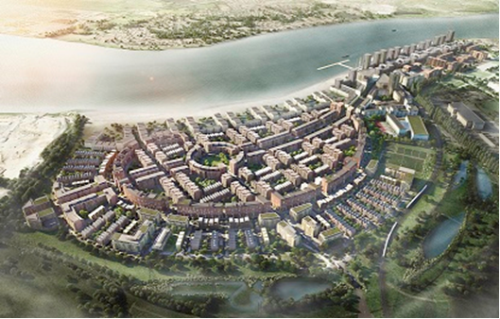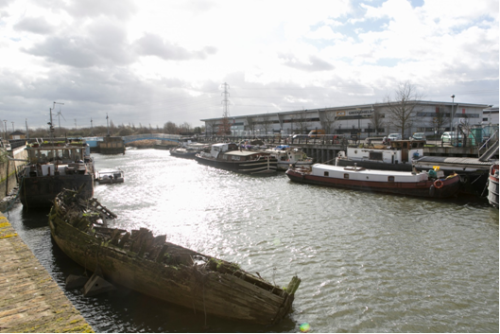A sense of place: what's health got to do with it?
If you ask individuals what 'sense of place' means to them, they offer up thoughts like 'it's the people', 'a place with history', 'a place I feel connected to', as well as 'sights, sounds and smells.' The academic literature supports this. For example, we know that 'place attachment', which is the psychological term, is good for mental wellbeing and emerges from a variety of experiences and situations, often related to parks, green spaces, and natural areas.
There is also a growing literature about the importance of access to 'blue space' to sustaining health and reducing health inequalities. This is of particular interest to those of us working in Barking Riverside which has 2km of River Thames frontage as well as rainwater gardens and [flood] balancing ponds designed in to the development as features for people and wildlife. And despite being a 21st century 'new town', Barking Riverside has a rich maritime, natural and industrial heritage embodied dramatically on the site by the former power station which was the centre of its industrial purpose until the 1980s. Organisations such as the Creekmouth Preservation Society are playing a crucial role in educating incoming residents about this history and bringing generations as well as older neighbouring communities and newer ones together.

Courtesy of Barking Riverside Limited
Healthy New Town
In April 2016, Barking Riverside successfully bid to be designated an NHS England Healthy New Town as part of a programme (opens new window) which aims to promote wellbeing and independence through cutting edge approaches to built environment design and new models of care. Barking Riverside, in the London Borough of Barking and Dagenham is one of ten demonstrator sites and is the only one in the capital. It covers 179 hectares of land and by 2030 will comprise 10,800 homes with approximately 29,000 people, as well as provision for 65,000sq.m. commercial floor space for shopping, restaurants, cafes, community and leisure facilities, healthcare and schools. There will also be a large proportion of public open space, public squares and a brand new rail station with bus and river transport interchange providing links to central London.
A place which is healthy for all
Our vision is for Barking Riverside to be 'a place which is healthy for all who live and work in and around the area'. The opportunity of building afresh on what is one of Europe's largest brownfield sites is a welcome one, but this is in the context of a borough which currently has poor health and social outcomes and is one of the most deprived in England and Wales. The council is alive to this, and clear that large-scale growth must not only establish attractive and liveable neighbourhoods for new residents but also improve the lives of existing residents. (i)
Ten Principles
An early achievement of the Barking Riverside Healthy New Town partnership (ii) was to embed 10 Healthy New Town Principles (opens new window) within the S106 agreement with the developer Barking Riverside Ltd (a joint venture between the GLA and L&Q Housing Association) which are now being adapted as part of the Local Plan refresh to ensure the benefits are felt borough-wide. These principles span cross-cutting objectives, such as reducing health inequalities and enabling community leadership, and more specific ones promoting active travel and access to fresh food.
Five priorities
In addition to this, we have identified five priorities. These are derived from extensive community engagement and input from experienced practitioners and researchers across public health, health and social care, regeneration, community development and planning. They are:
- Future health and care, ensuring that prevention and early intervention is at the heart of innovative, integrated service provision
- A connected community in which the new and existing communities of Barking Riverside and its surrounding areas are linked physically, socially and economically
- A place which meets and adapts to people’s needs and actively promotes lifelong health
- A place which promotes and enables a healthy mind and body
- A sense of place with an inspiring built and natural environment which enhances wellbeing.
Sense of place is, in many ways, the most elusive and yet, arguably, the most critical to success in what we now call 'placemaking'. We have defined this priority further as 'A "sense of place" with an inspiring built and natural environment which enhances wellbeing and is valued by citizens and visitors for its social, cultural, heritage, diversity, economic and natural assets. It will be a "destination" – drawing people and businesses to live, work, visit and invest in the area.'
Two themes
So how is the Healthy New Town partnership hoping to stimulate and foster a sense of place? Our Delivery Plan for 2017-19 contains a number of projects or activities which either directly or indirectly support this and which complement the efforts of others. Direct activities are clustered around the two themes of 'Making the most of the riverside' and 'Green health/blue health'.
'Making the most of the riverside' will entail working with the community and cultural stakeholders to make a substantive contribution to the Placemaking Strategy which places the river and riverfront at the heart of the Healthy New Town. This will span physical and social and cultural activity, transport and economy and the environment, and emphasise inclusion and connectivity. For example, a repurposed wharfside will revitalise its historic fabric providing opportunities for cafes and performance spaces as well as 'industrial habitat gardens' and spaces to sit outside and enjoy the water, flora and fauna.

Courtesy of Agnese Sanvito
Through 'Green health/blue health', we aim to build nature into the narrative of people’s lives, using green and blue space assets to encourage active lifestyles and create places for rest, relaxation and wellbeing. We also want to provide reasons to be proud of the rare and treasured species, such as water voles, taking up residence alongside people, and to contribute to conservation and ecosystem restoration in order to deliver health and environmental co-benefits. In practical terms, this will include, for example, community participation in conservation work linked to potential voluntary and paid roles, and tie-ins with the schools biology and geography curricula via the Greenthink Centre, which will be part ecology centre, part city farm, part education resource. The plan is to co-design and deliver, with the community, activities which will generate new evidence about the contribution of blue space to physical and mental health, with academic partners such as the European Centre for Environment and Human Health, at the University of Exeter.
Immeasurable value?
A pressing job for us now is to define measurable outcomes arising from the Healthy New Town initiative with which we can monitor real improvements - or not - in health and wellbeing over time. We are particularly interested in whether and how to quantify the health gain from a sense of place. To do this, we are drawing on the expertise of academic colleagues and participating in a national Evaluation Collaborative; but we are keen to hear from anyone with relevant expertise and experience, whether from previous 'new town' initiatives or working with communities on a smaller scale in areas of regeneration or growth.
(i) ‘No-one left behind: in pursuit of growth for everyone’ was recognised as an underlying principle in Barking and Dagenham’s Independent Growth Commission Report (2016) (opens new window) and is the core ambition of the borough’s emerging Local Plan (opens new window).
(ii) The Barking Riverside Healthy New Town partnership comprises the London Borough of Barking and Dagenham, Care City, NHS Barking and Dagenham Clinical Commissioning Group and Barking Riverside Ltd as well as an extensive network of local stakeholders.

Comments
Posted on by Nancy Clark
would love to know what, if any, specific LGBT service provision has gone into this project?
best wishes,
Nancy Clark
Occupational Therapist/ PhD researcher
Posted on by Catherine Max
Hi Nancy - Thanks for reading my blog and for your query. First thing to say is that what we are doing at the moment is focused on the built environment design rather than services, as such. Having said which, work is beginning to engage people regarding the form of future health and care provision. This is being led by the local NHS. I can say something about the general approach we are taking, though. With respect to the Healthy New Town, our top principles express commitment to inclusion and equalities and this embraces sexuality and gender identity, of course. The council, under whose auspices the programme sits, is active in its commitment to LGBT equality. This is evidenced in a range of ways eg involvement in LGBT History Month and associated events, and staff support and networking groups for LGBT employees. I shall draw my NHS colleagues' attention to your query regarding service provision. Hope this helps!
Catherine
Add your comment